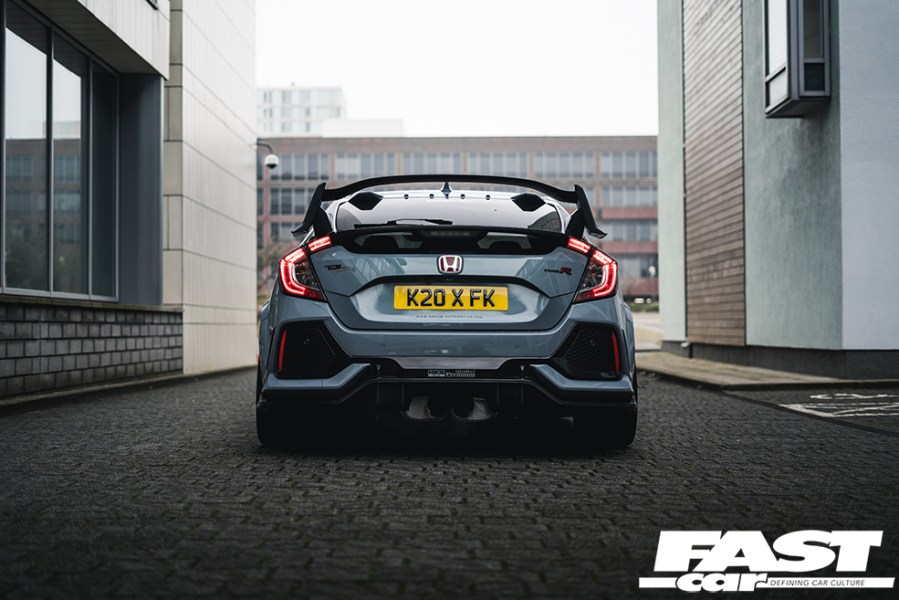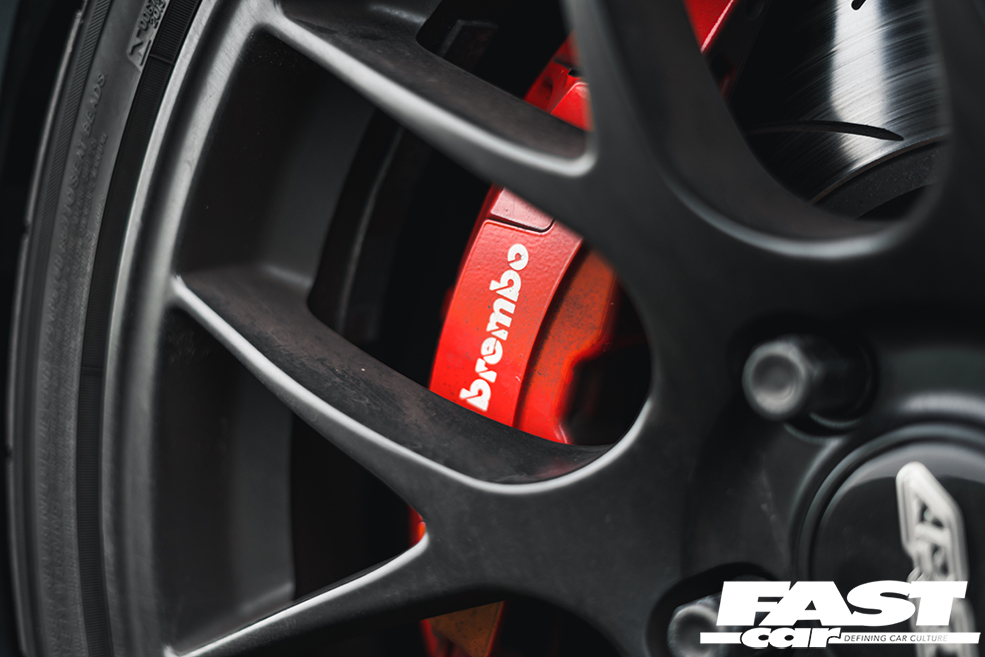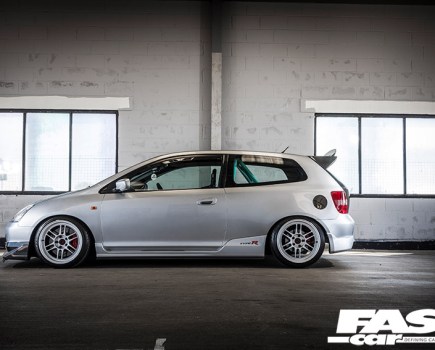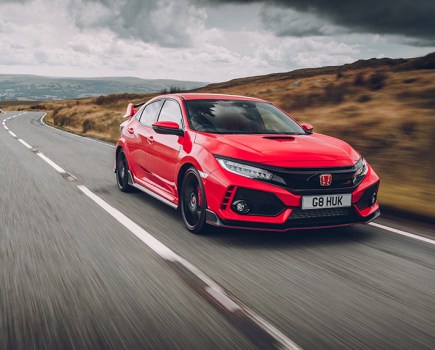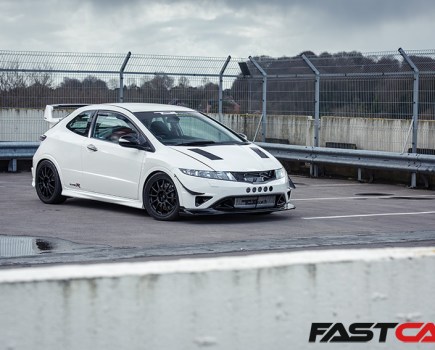Delivering incredible performance in stock form, the Honda Civic Type R FK8 is a sensational hyper hatch and one that offers up a vast choice of tuning options that will allow you to take it to the next level. We check out the best performance, handling and styling upgrades for your Honda.
On sale from 2017 to 2021, the Honda Civic Type R FK8 was an incredible machine at launch and is still an epic hot hatch today. Its 2.0-litre turbocharged VTEC makes 320hp (316hp in the US), which means a 0-62 time of 5.7 seconds and a 169mph top speed. Honda managed to get it around the Nürburgring in a frantic 7:43.8. This is a serious performance car out of the box. Honda’s engineers really put the work in, blessing it with a superb chassis and wild-looking but fully functioning aero. This means the FK8 is the perfect starting point for modding.
There’s a lot of power on tap, and thanks to the turbocharged VTEC there’s plenty of scope for even more, the suspension is just begging to go to the next level to make the most of the chassis, and that goes hand-in-hand with some brake enhancements. And with the aftermarket absolutely packed with FK8 upgrades, you’re absolutely spoilt for choice, which makes Honda Civic Type R FK8 tuning as easy as you like, and you can put together an epic machine with very little effort.
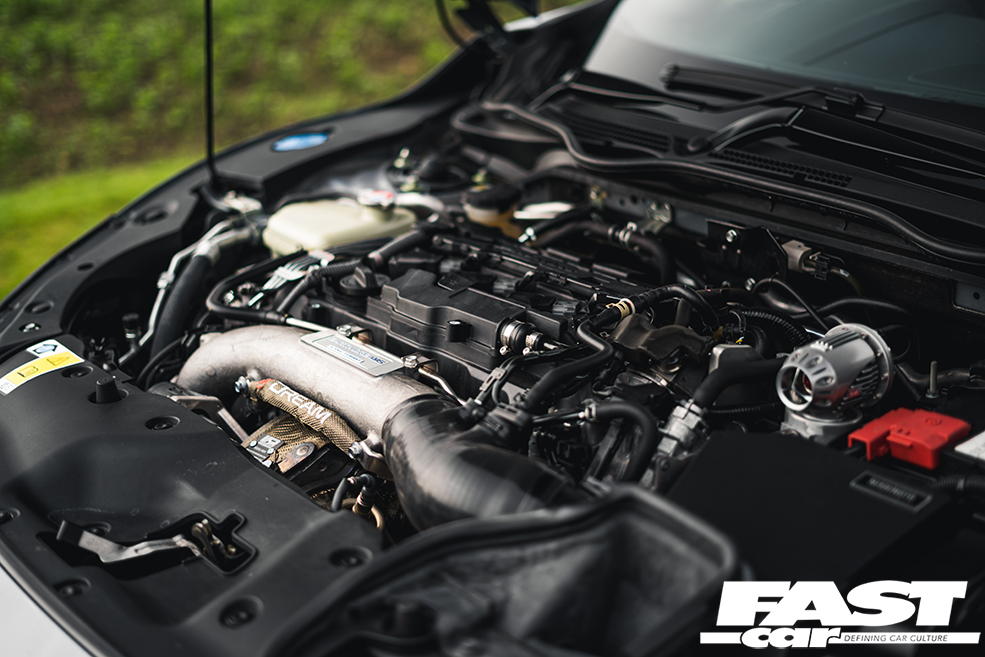
Honda Civic Type R FK8 Tuning – Engine and Transmission
While die-hard fans might lament the loss of the frantic NA VTEC engines that powered Civic Type Rs of the past, the switch to turbocharging with the FK2 generation model suddenly made getting more power a whole lot easier, and there’s a lot to like about that. With the FK8 continuing this new turbocharged trend you’ve got countless options available to you whether you’re just looking for a small boost in power, or you want to go full-on.
Start With Software
When it comes to Honda Civic Type R FK8 tuning, the easiest way to get more power out the engine is without a shadow of a doubt a remap, and this alone will be enough to net you an additional 50hp or so. Your main options are to either go for a custom ECU map or get a map using something like a KTuner. A rolling-road map would yield an additional 40-50hp and 40-50lb ft of torque, while a KTuner plug-in unit will cost you $700 / £650 and will give similar results, but more options for different maps and future upgrades. This alone will be enough for most people because you’ll now have between 360-370hp to play with and that’s plenty to be getting on with, but there are also plenty more options available for those that want more.
Release The Cat
With any turbocharged engine, it’s all about removing restrictions in the exhaust system and maximizing gas flow, and the biggest restriction is the cat that’s located in the downpipe. You have two choices here – either go for a de-cat downpipe or a sports cat item. The former is significantly cheaper, and they start from about $300 / £250, with other options similarly priced. A de-cat downpipe will also flow much better, meaning bigger potential performance gains.
However, going de-cat will tend to introduce nasty-smelling exhaust fumes into the cabin when you’re stationary, and you also won’t pass an MOT on emissions, a visual inspection or US Smog Laws. A high-flow sports cat downpipe is more expensive, with the cheapest being offered for around $500 / £500. It won’t flow quite as well as a de-cat, but you won’t get those exhaust fumes and it will still allow your car to pass emissions testing, so the choice is yours. A downpipe alone will add around 10-20hp, but it pairs exceptionally well with a remap and with that combo on board you will be knocking on the door of around 400hp.
Laying Foundations
The mods beyond this point are more about support for the next stage of tuning rather than about outright gains on their own, but they all play an important part in the process. An uprated intercooler is always a good idea when you’re upping boost and power as it helps to keep intake air temperatures down, which means the engine won’t pull ignition timing and will be able to make more power more consistently. The HKS option ($850 / £800) is a strong option, providing a 100mm-wide core that delivers a 200% increase in surface area that can give an extra 10hp at peak, while cheaper options start at just under $500 / £500 for the Forge item.
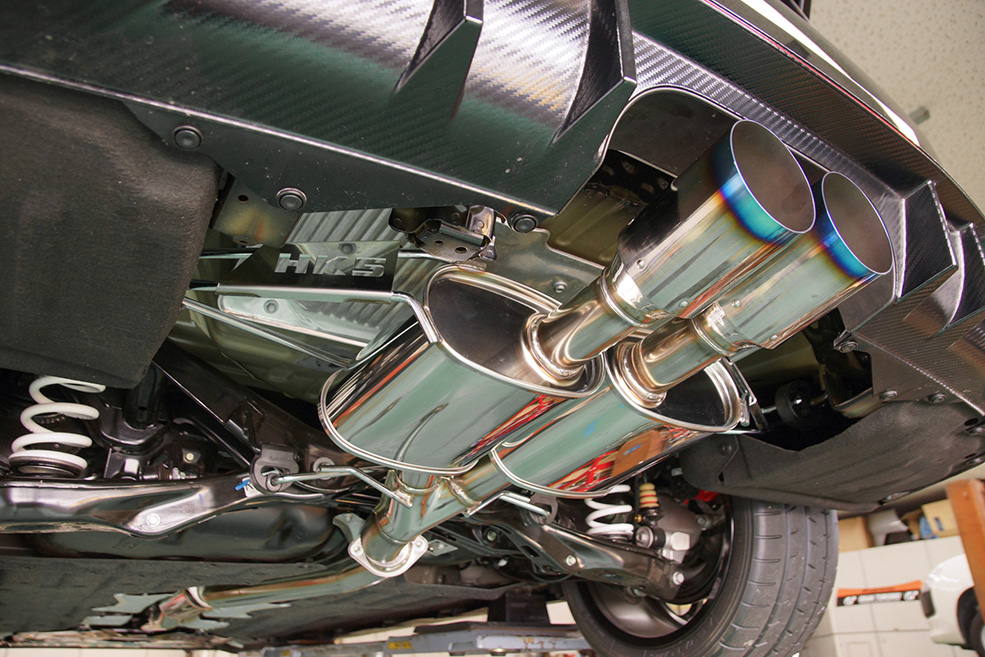
The stock fuel pump is also restrictive and limits how much power you can make – at the basic remap and downpipe stage it will be fine though already running close to its maximum flow rate, and if you want to take things further, you’ll need an upgrade. The FK8 Clinic sells the Xtreme-DI EVO HPFP, which offers a 36% increase in capacity over the stock pump and costs $1600, so around £1600 after shipping and duty to get it into the UK. Another option is the Hondata Fuel System Upgrade kit, available for £2800 from places like Tegiwa Imports or CPL Racing, which includes a pump that delivers 24% more flow than the stock Bosch pump, and also comes with a high-flow ethanol-rated in-tank low-pressure fuel pump, high-flow high-pressure fuel line, high-flow fuel injectors, a low-pressure fuel line and precision Hondata FlashPro software control.
Getting Serious
The next stage after this is to make the most of all those supporting mods and fit an uprated turbo, a drop-in one that uses the existing manifold and doesn’t need masses of work to install. There are a lot of choices out there depending on what you’re looking for. Turbozentrum offers an MHI Mitsubishi unit rated for 450hp for £1732, and for just over £2000 you can pick up a turbo rated for up to 560hp from Dream Automotive or Tegiwa. TDI North sells a turbo for £2500 that is capable of delivering over 500hp, while for £2600 you can pick up a turbo rated for 600whp, but at that power level, you’ll be needing a fully forged engine.
If you’re planning on track work, an uprated oil cooler is a worthwhile investment and the HKS oil cooler kit ($900 / £875) keeps operational temperatures low under stress, with the knock-on benefit of lowering water temps too, so you’re less likely to hit limp mode on the circuit.
It’s All About Air Flow
At lower power levels, the stock intake, front pipe and exhaust are fine, but once you’re running over 400hp and a hybrid turbo, it will be worth upgrading these to minimize restrictions. Injen’s Evolution cold air intake system ($370 / £350) is well regarded, being a direct replacement item with dyno-proven gains up to 13hp and 18lb ft; another induction alternative is the Mishimoto Performance kit ($465 / £497), which has been designed to look like a factory-fit item and company claims a very precise 16.7whp increase.
The front pipe replaces the restrictive length of stock pipe in the exhaust system that comes after the downpipe and will increase exhaust noise as well as aiding exhaust flow. The cheapest one that works with the stock exhaust system is the PRL one, which can be picked up for £420.
Exhaust options are numerous, with the LEGAMAX system from HKS ($1300 / £1800) being among the most desirable. This swaps out the stock triple-pipe exhaust tip arrangement for two fat pipes with a burnt blue titanium finish, the 75mm main pipe diameter and straight design reducing exhaust pressure by 50%, which allows the turbo to run more efficiently at lower rpm. Milltek’s system comes in at $1200 / £1300 and boasts equally impressive gains along with a trio of 100mm tips.
Transmission Tips
As far as the transmission is concerned, the stock clutch is fine for up to 450lb ft of torque, so it’s unlikely that you’ll have to upgrade it unless you are really pushing the performance envelope. If you’re looking for something that feels close to stock, owners like the combo of the Clutch Masters FX350 (approx. £700) along with the matching lightweight flywheel (approx. £525).
The other thing you’ll want to do if it’s not already been done is to get the clutch delay valve removed. This controls the rate at which the clutch can engage, regardless of how quickly you come off the clutch, and not only can it make you look like a learner driver, it is often cited as contributing to the infamous second-gear grind. The CDV is located in the clutch slave cylinder and the easiest option is to buy a new slave cylinder (£120), remove the CDV using one of the many detailed guides you can find online, and then simply swap it over with the part on the car, which will streamline the whole process. If you do that, you’ll have a much-improved clutch feel and the driving experience will be all the better for it.
Honda Civic Type R FK8 Tuning – Suspension, Brakes & Wheels
The fifth gen CTR handles brilliantly out of the box, but there’s always room for improvement, and there are lots of options when it comes to Honda Civic Type R FK8 chassis tuning.
Best Budget Options
At the bottom end of the price range, you’ve got springs, which will get your CTR sitting a little lower, as well as firming up the suspension and reducing body roll, and they will work perfectly with the stock adjustable dampers. Tein kits start from $200 / £144 while a set of Eibach Pro-Kit springs will set you back around $350 / £280.
Another good value upgrade is a thicker rear anti-roll bar (the stock item is 20.5mm thick), and fitting one will dial out understeer and give the chassis a slight tendency to oversteer, which can be seen as a benefit in a front-wheel drive car. There are a few available, such as Eibach’s two-way adjustable offering, which is tubular, making it lighter, and it comes as either a 22mm or 25mm option, with the thinner one available for £180 while the thicker item is available for about £230.
Coilovers
If you’re serious about handling and are looking for something that will offer a big upgrade over the stock setup, you’ve got to look at coilovers. These will obviously remove the factory adjustable damping but will give you a lot more adjustment in terms of fine-tuning how the car drives, as well as plenty of lowering range. Coilovers are never cheap, however, Tein’s Flex A kit is the most affordable at $1400 / £1392. What’s more, the coilovers are compatible with Tein’s own EDFC Active Pro kit ($750 / £823). This replaces the adjustment knobs on the dampers with stepper motors that can be controlled from the cabin, allowing you to adjust the damping on the fly using the control unit.
Keeping Things In Check
In terms of brakes, the stock setup is absolutely fine for fast road use running stock power, but once you start upping the boost and increasing your speed, you’re definitely going to want to upgrade your stopping power. First up, get a good set of brake pads in the calipers, and here you are spoilt for choice – EBC Yellowstuff ($150 / £113) are a decent fast-road and occasional track choice, as are Spoon pads ($260 / £245). A braided line kit like the Forge one ($200 / £144) helps to firm up brake pedal feel, and some DOT 5.1 brake fluid will ensure your brakes won’t wilt under high temperatures.
The next step would be to fit some two-piece rotors, which reduce unsprung weight and improve brake cooling. You can pick up a pair of genuine Honda items for £320 for the pair from TDI North, a pair of DBA items will set you back £436, while EBC’s two-piece rotors are £888 for the pair. Finally, if you want to go all-out and fit a BBK, you’ll be looking at $2300 / £2432 for the Yellowspeed front kit with eight-pot calipers and 380mm rotors.
Downsizing
As far as alloy wheels are concerned, the FK8 comes with 20s as standard unless you opt for the Sport Line, which came with 19s. Owners have found that dropping down to 18s robs you of steering feel as well as increasing torque steer slightly, however, you can opt for lighter wheels, which will reduce unsprung weight, and smaller wheels will also improve the ride. Going lower at 18s does offer more overall grip, however. Whatever size you opt for, you want a lightweight wheel, something flow-formed from the likes of APEX, or something forged if you’re feeling flush, like the legendary TE37, which is as popular as ever.
Check out our best Honda Civic Type R wheels guide for some FK8 wheel inspiration.
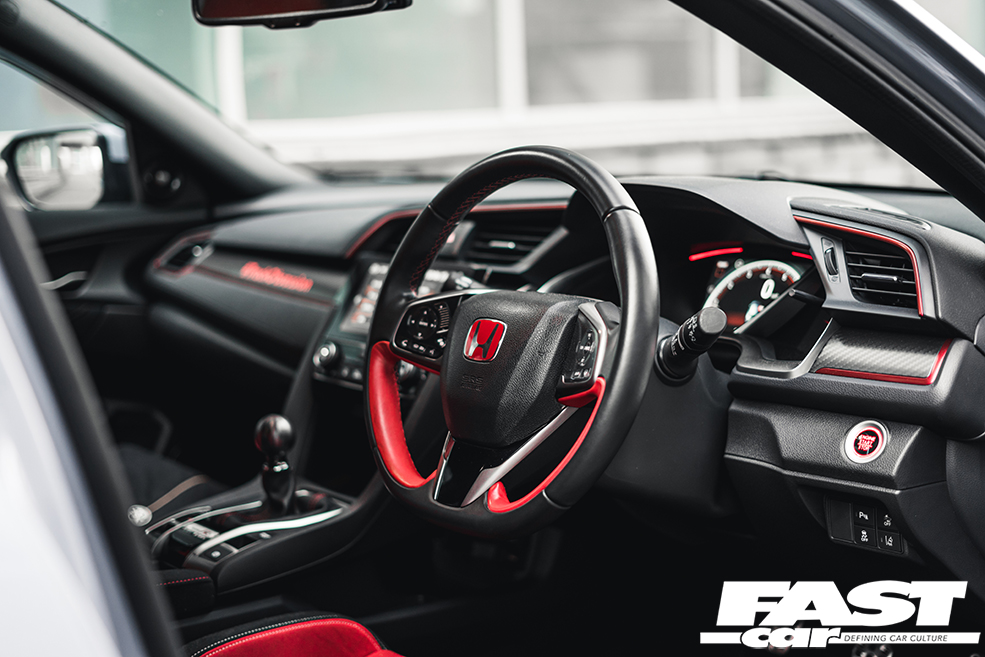
Interior Upgrades
The Civic Type R FK8’s stock gear shift is good, but an Acuity short-shifter will make it that much better, reducing shift throw and making shifts faster and snappier. We’d pair that with a new gear knob – the Raceseng Slammer is popular, and weighs 635g, giving you a lovely shift action combined with an ergonomic shape that perfectly fits the palm of your hand. And if you’re serious about driving, Acuity offers a throttle pedal spacer that moves the accelerator closer to you, aligning it with the brake pedal for much improved heel-and-toe action. And, while the standard seats are very nice, a pair of Spoon carbon fixed-back buckets or Mugen MS-Rs would definitely make a difference to your driving experience.

Styling Modifications
The Honda Civic Type R FK8 isn’t short on aggression when it comes to its styling, but there’s plenty you can do to make it look even more special. As a result, we’d kick things off with a splitter, and the APR carbon item looks great, with its support struts and features a fully functioning flat undertray.. The ultra-aggressive Mugen rear diffuser would also find its way onto our shopping list. A carbon bonnet would look awesome on the FK8, and prices start from $1300 for the Seibon item and there are a lot of different designs to choose from. And, finally, if we were really going to blow the budget, the Mugen carbon rear wing looks incredible, though it wants to for £3150.
One last mod that people recommend is a set of rock guards, as the FK8 has a habit of throwing a lot of stones up the sides of the car as you drive along, which will cause paint damage. A set of rock guards fitted to the inside rear of your wheel arches will help to prevent this from happening, they are discreet, and a set from ZL1 Addons will set you back $87, making them an inexpensive but worthwhile addition.
Check out our FK8 buyer’s guide if you’re looking to get behind the wheel of one.

